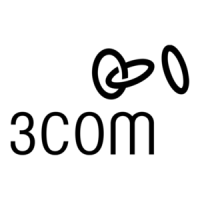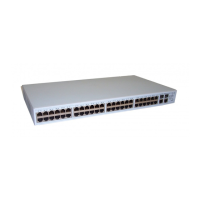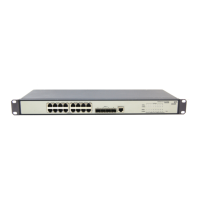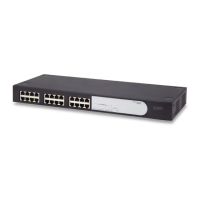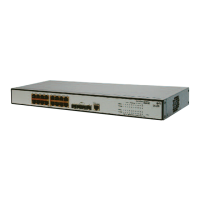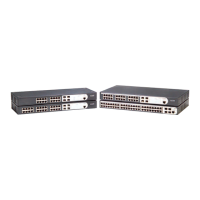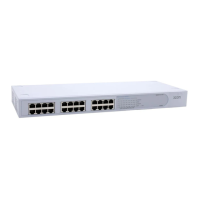Do you have a question about the 3Com Baseline Switch 2250-SFP Plus and is the answer not in the manual?
Explains the various conventions used throughout the guide for clarity.
Provides information on how to submit feedback and suggestions for the documentation.
Details the process and importance of registering the switch for warranty and service benefits.
Provides a general introduction to the Baseline Switch models and their intended use.
Highlights the key features and technical capabilities of the switch models.
Describes the physical components and layout of the switch's front and rear panels.
Explains the function and connection requirements for the switch's console port.
Details the function and indications of the power status LED on the switch.
Provides critical safety instructions and precautions for installing and operating the switch.
Offers guidelines for selecting an appropriate and safe location for the switch.
Describes methods for mounting the switch in a rack or placing it in a free-standing configuration.
Explains the procedure for connecting and supplying power to the switch safely.
Guides on how to insert and use Small Form Factor Pluggable (SFP) transceivers.
Outlines regular checks to ensure the switch is operating correctly and to identify potential issues.
Lists the necessary components and software for accessing the switch's web interface.
Explains how to use the CLI for initial switch configuration and IP address management.
Details the steps required to successfully log in to the switch's web management interface.
Provides an overview of the web interface layout, menus, and system information.
Guides on using the utility to automatically locate and connect to the switch.
Displays basic switch settings, component versions, and port status summaries.
Explains how to configure static or DHCP IP addresses for network communication.
Covers managing user accounts, access levels, and passwords for switch security.
Details the process of creating and managing Virtual LANs for network segmentation.
Illustrates practical examples of setting up VLANs for network segmentation.
Guides on configuring port speed, duplex, flow control, and link aggregation.
Explains how to combine multiple ports into a single trunk for increased bandwidth and resilience.
Covers configuring RADIUS client and 802.1X authentication settings for network access control.
Describes how to display address table info, set up port mirroring, and perform cable diagnostics.
Explains the utility for detecting and resolving issues with attached network cables.
Provides steps to restore the switch to its original factory default configuration.
Offers solutions for regaining access if the static IP address of the switch is forgotten.
Helps diagnose problems by interpreting the status of the front panel LEDs.
Provides guidance on what information to have ready when contacting support for unresolved issues.
Explains how to register the product to ensure full warranty and service benefits.
Details options for enhancing support, warranty, and service levels.
Provides information on obtaining telephone support and arranging for repairs.
Lists contact methods for technical support and repair services by region.
Lists the standards, functional, physical, and electrical specifications for the 3CBLSF26 model.
Lists the standards, functional, physical, and electrical specifications for the 3CBLSF26PWR model.
Lists the standards, functional, physical, and electrical specifications for the 3CBLSF50 model.
Details the pinout configuration for the RJ45-to-DB9 console cable.
Provides pinout diagrams for Null Modem cables connecting RJ45 to RS-232.
Details the pin assignments for Ethernet ports configured as MDI and MDIX.
Introduces the CLI for device management and configuration tasks.
Explains how to connect to the device via the console port to access the CLI.
Details the user name and password process for logging into the CLI.
Lists and briefly describes the available commands for managing the switch via CLI.
Explains the Ping command for testing network connectivity to remote devices.
Describes how to configure IP addresses manually or via DHCP using the CLI.
Details the Initialize command for resetting device configuration to factory defaults.
Provides compliance information related to FCC regulations for Class A digital devices.
Confirms compliance of the digital apparatus with Canadian ICES-003 standards.
Details compliance with European directives for low voltage and EMC.
Explains the various conventions used throughout the guide for clarity.
Provides information on how to submit feedback and suggestions for the documentation.
Details the process and importance of registering the switch for warranty and service benefits.
Provides a general introduction to the Baseline Switch models and their intended use.
Highlights the key features and technical capabilities of the switch models.
Describes the physical components and layout of the switch's front and rear panels.
Explains the function and connection requirements for the switch's console port.
Details the function and indications of the power status LED on the switch.
Provides critical safety instructions and precautions for installing and operating the switch.
Offers guidelines for selecting an appropriate and safe location for the switch.
Describes methods for mounting the switch in a rack or placing it in a free-standing configuration.
Explains the procedure for connecting and supplying power to the switch safely.
Guides on how to insert and use Small Form Factor Pluggable (SFP) transceivers.
Outlines regular checks to ensure the switch is operating correctly and to identify potential issues.
Lists the necessary components and software for accessing the switch's web interface.
Explains how to use the CLI for initial switch configuration and IP address management.
Details the steps required to successfully log in to the switch's web management interface.
Provides an overview of the web interface layout, menus, and system information.
Guides on using the utility to automatically locate and connect to the switch.
Displays basic switch settings, component versions, and port status summaries.
Explains how to configure static or DHCP IP addresses for network communication.
Covers managing user accounts, access levels, and passwords for switch security.
Details the process of creating and managing Virtual LANs for network segmentation.
Illustrates practical examples of setting up VLANs for network segmentation.
Guides on configuring port speed, duplex, flow control, and link aggregation.
Explains how to combine multiple ports into a single trunk for increased bandwidth and resilience.
Covers configuring RADIUS client and 802.1X authentication settings for network access control.
Describes how to display address table info, set up port mirroring, and perform cable diagnostics.
Explains the utility for detecting and resolving issues with attached network cables.
Provides steps to restore the switch to its original factory default configuration.
Offers solutions for regaining access if the static IP address of the switch is forgotten.
Helps diagnose problems by interpreting the status of the front panel LEDs.
Provides guidance on what information to have ready when contacting support for unresolved issues.
Explains how to register the product to ensure full warranty and service benefits.
Details options for enhancing support, warranty, and service levels.
Provides information on obtaining telephone support and arranging for repairs.
Lists contact methods for technical support and repair services by region.
Lists the standards, functional, physical, and electrical specifications for the 3CBLSF26 model.
Lists the standards, functional, physical, and electrical specifications for the 3CBLSF26PWR model.
Lists the standards, functional, physical, and electrical specifications for the 3CBLSF50 model.
Details the pinout configuration for the RJ45-to-DB9 console cable.
Provides pinout diagrams for Null Modem cables connecting RJ45 to RS-232.
Details the pin assignments for Ethernet ports configured as MDI and MDIX.
Introduces the CLI for device management and configuration tasks.
Explains how to connect to the device via the console port to access the CLI.
Details the user name and password process for logging into the CLI.
Lists and briefly describes the available commands for managing the switch via CLI.
Explains the Ping command for testing network connectivity to remote devices.
Describes how to configure IP addresses manually or via DHCP using the CLI.
Details the Initialize command for resetting device configuration to factory defaults.
Provides compliance information related to FCC regulations for Class A digital devices.
Confirms compliance of the digital apparatus with Canadian ICES-003 standards.
Details compliance with European directives for low voltage and EMC.
